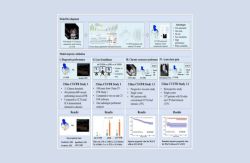Laryngeal cancer is a significant issue in the UK, affecting around 2400 people annually. Symptoms include hoarse voice, pain, or difficulty swallowing. Diagnosis involves endoscopic visualisation, biopsy, and imaging, with staging based on the TNM system. Advanced cases have a poor 5-year survival rate. Treatment decisions are complex and involve multidisciplinary teams considering surgery, chemoradiotherapy, or radiotherapy. Despite efforts, there's a lack of effective decision-making models. Radiomics, a method of extracting quantitative information from imaging, shows promise in refining management. This involves analysing tumour shape, texture, and intensity to create predictive models. While radiomics has shown potential in other cancers, its use in laryngeal cancer remains underexplored. A pilot study published in The Journal of Laryngology & Otology aims to determine whether radiomics analysis can predict survival and identify potential prognostic biomarkers in advanced laryngeal cancers.
Understanding the Landscape of Laryngeal Cancer Management
A retrospective cohort of 72 patients with advanced laryngeal squamous cell cancer (SCC) from Newcastle-Upon-Tyne NHS Foundation Trust was analysed using radiomics. Patients were diagnosed between August 2013 and October 2019. Strict selection criteria were applied, excluding those with metastatic disease or who received only palliative care. All patients underwent pre-biopsy, contrast-enhanced CT imaging and staging via the TNM system. CT scans were obtained using the same scanner and contrast protocol to limit bias. Most patients were male, current smokers, with a median age of 66 years. Nearly half received concurrent chemoradiotherapy. The median follow-up was 3.55 years, with a disease-specific mortality rate of 31%.
Analysing Radiomic Features in a Retrospective Cohort of Advanced Laryngeal Cancer Patients
Two radiomics features, shape compacity, and grey-level zone length matrix – grey-level non-uniformity, were identified as prognostic markers for survival using a Cox regression model. Univariate analysis showed that higher values of both features were associated with worse 5-year disease-specific survival. Patients with upper tercile values for these features had significantly worse survival rates compared to those in the middle or lower tercile groups. Even when considered alongside major clinicopathological factors, these radiomic markers remained statistically significant predictors of survival. Combining both radiomic markers into the same model further improved the prediction of 5-year disease-specific survival compared to models using only clinicopathological variables. The higher C-index from the combined radiomics model suggests the potential of integrating radiomic features for more accurate survival modelling.
Identifying Prognostic Radiomic Markers for Disease-Specific Survival in Advanced Laryngeal Cancer
This study focused exclusively on disease-specific survival in advanced laryngeal cancer, utilising pre-biopsy, contrast-enhanced CT scans to identify two radiomic features with significant prognostic potential: shape compacity and grey-level zone length matrix—grey-level non-uniformity. These features, markers of tumour heterogeneity and irregularity, were associated with worse 5-year disease-specific survival. The study found that integrating radiomic features into survival models resulted in more accurate prognostication compared to models using only clinicopathological variables, as demonstrated by a higher C-index. This approach could enhance patient care by providing non-invasive methods of evaluating tumour heterogeneity, potentially reducing the need for invasive biopsies and aiding in treatment planning.
While the study had limitations, such as its retrospective, single-centre nature and small sample size, it provides promising evidence for the future development of radiomics-based models to refine the management of advanced laryngeal cancer and improve survivorship.
Source: The Journal of Laryngology & Otology
Image Credit: iStock























